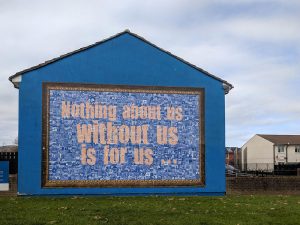
This article was originally printed in the Fall-Winter 2011 edition of the Nonprofit Quarterly, “A New Day: Contemplating 2012.” It was first published online on December 13, 2011.
A board-approved merger between two nonprofits is quashed due to pressure from donors. Two Girl Scouts mobilize opposition to the use of palm oil in Girl Scout cookies and get the nonprofit to change the recipe. A recreation center on the verge of closure is prevented from doing so by the work of community members. A labor dispute between musicians and management in the Detroit Symphony Orchestra leads to the creation of an advocacy group that becomes a powerful voice in the negotiation process. These examples highlight an emerging phenomenon that is gaining momentum worldwide—that of what we are calling “stakeholder resistance,” but what some executive directors may experience as “stakeholder rebellion.”
What Exactly Is Stakeholder Resistance?
What is interesting about stakeholder resistance is that it originates with individuals who are not “insiders” in organizations, and that these “outsiders” are at times engaging in acts that challenge, disrupt, and even change organizational policies, practices, and actions. These individuals can actually limit the autonomy of organizational decision making, yet they are not legislators, lobby groups, or key funders. Generally speaking, an organization’s stakeholders are those who are linked to an organization in ways other than a formal contract.1
In the case of nonprofits, stakeholders often include donors, members, and community members who engage with the organization either directly or indirectly.2 Frequently, a strategic planning process includes a stakeholder analysis—an exercise that involves identifying key stakeholders as well as their interests and sources of power. The really influential, or those whose interests are perceived to be a threat, are then attended to, and the rest are mostly ignored. Clients being served or small, widely distributed individual donors are examples of those who have traditionally been seen to have interests in alignment with those of the organization or as having diffuse power bases and hence not necessary to include in a strategic planning process.
The term resistance was originally used with a negative connotation, as in “resistance to planned and top-down change,” and it implied that compliance with the dictates of the leadership was expected and positive.3 Since then, the term has been reclaimed by more critical scholars as an act of purposefully undermining the status quo and the taken-for-granted ways things are always done, and resistance is celebrated as an act that pushes back on established power relations.4 Within the second tradition, studies have focused primarily on two types of resistance: workplace resistance and civil society resistance. Workplace resistance focuses on how workers resist employer practices, actions, and rules. This resistance consists of both overt actions such as strikes, whistle blowing, and sabotage and more covert actions of resistance through rhetoric, shirking, cynicism, and humor.5
Research on civil society resistance, on the other hand, has focused well outside the domain of the organization and examines social movements and the processes by which groups form resistance against dominant rules, norms, or practices in society.6 Environmental NGOs have received particular attention for their acts of resistance. For example, the actions taken by Greenpeace to prevent Shell Oil’s decision to dispose of an oil-storage buoy in the deep sea eventually resulted in Shell’s overturning its initial decision.7 Civil society resistance differs from workplace resistance because it emerges from an external source, whereas workplace resistance emerges internally.
Stakeholder resistance, we are suggesting, falls in the space between workplace resistance and civil society resistance.8 These stakeholders are not employees of an organization but are likely more closely connected to the organization than the broader civil society. Take the case of the failed merger between Smile Train and Operation Smile—two organizations that repair cleft palates of children across the world. The resistance to the merger planned by the two boards of directors emerged primarily from the Smile Train donors, who mobilized opposition to the merger though an online petition.
In the case of the resistance enacted against the Girl Scout organization for its use of palm oil in cookies, it was two members of the girl scouts who engaged in the resistance. Fifteen-year-old Rhiannon Tomtishen and sixteen-year-old Madison Vorva learned through a Girl Scout project that the habitat of orangutans in Southeast Asia was diminishing because rainforests were being cleared for palm oil plantations. Palm oil, as it turns out, is a key ingredient in all Girl Scout cookies. After a failed attempt at sparking change with the Girl Scouts directly, Rhiannon and Madison began mobilizing support from other activist groups such as Rainforest Action Network.
Stakeholder resistance can also emerge from community members who interact with an organization. When a YMCA in Elmira, New York, was on the verge of shutting down due to a lack of funds, over two thousand community members signed an online petition urging local officials to find a solution to keep the YMCA operating. Meanwhile, grassroots groups of students from a local university and local elders met to discuss how the Y could be saved. This resulted in the adoption of the YMCA by a local senior center, allowing it to continue to operate.
On other occasions, stakeholder resistance might emerge from several groups simultaneously. The dispute between musicians and management in the Detroit Symphony Orchestra led to the creation of an advocacy group called Save Our Symphony, composed of several stakeholder groups including donors, audience members, and the local community. As the above examples illustrate, stakeholder resistance is unique in that it emerges from individuals and groups who are connected to an organization but often don’t have the immediate access of an employee.
What Is Causing These Acts of Resistance?
While the specific causes of stakeholder resistance differ from organization to organization, it appears that underlying almost all the acts is a deep dissatisfaction with the organizations’ responsiveness to their stakeholders. Specifically, in each of the examples highlighted in this article the acts of resistance against the organization resulted from a lack of voice given to their stakeholder groups in organizational decisions. This marginalization of the stakeholders may stem from the fact that they were considered to be secondary stakeholders,which afforded them less of a direct influence on organizational decision making than primary stakeholders, such as board members.9 Furthermore, these secondary stakeholders are less organized than other broader stakeholder groups such as social movement organizations like the environmental NGOs mentioned earlier.10 Thus, with less assumed importance to the organization and less formal power, these stakeholders are often not given adequate attention by their focal organizations.11 Under these conditions of little formal voice and low organizational responsiveness, stakeholders who have a particular interest that they feel strongly about are more likely to engage in the types of resistance this article describes. It may also be the case that there may be a triggering event that activates resistance and that these events are difficult to anticipate. As the resistance mobilizes and the emotional subtext gets more heated (these acts are often accompanied by anger or anxiety), there is an amplification of a collective voice among what are normally diffuse actors.
Although these stakeholders are often in marginalized positions vis-à-vis the organizations, the organizations often attempt to communicate with them. Traditionally this has been through publications such as newsletters, which represent one-way communication mechanisms. The collective voice of stakeholders would traditionally be at a membership meeting, and while revolts have taken place in such forums, they could also at times be anticipated and managed. Nonprofit leaders recognize that these stakeholders have a critical role in the success of the organization, and failure to meet the needs of stakeholders can have many negative consequences.12
Sign up for our free newsletters
Subscribe to NPQ's newsletters to have our top stories delivered directly to your inbox.
By signing up, you agree to our privacy policy and terms of use, and to receive messages from NPQ and our partners.
What Is Enabling These Acts of Resistance?
What has caused this apparent surge of stories of stakeholder resistance? Why now? One commonality to all these examples is the presence of social media as a tool for stakeholder communication, mobilization, and engagement. As recent examples in Egypt and Libya have demonstrated, social media sites such as Facebook and Twitter can play a large role in activism and resistance. There are several reasons for the effectiveness of social media in resistance—primarily, the direct, efficient, and low cost of Internet communication provides a powerful tool to engage a wide variety of stakeholders who may be isolated from traditional forms of collective action.13 Interestingly, the interactivity of social media facilitates an unprecedented degree of two-way communication between organizations and stakeholders. Increasingly, nonprofits are using social media to engage their stakeholders through information provision, disclosure of performance, fundraising, and two-way communication.14 This communication provides an avenue for organizations to engage stakeholders; however, it also provides a means for stakeholders to resist organizational actions or practices.
For example, the dispute in the Detroit Symphony Orchestra was made very public through social media, with the Save Our Symphony advocacy group creating a Facebook page where stakeholders could communicate with each other and the organization. Opposition to the Smile Train and Operation Smile merger and the closing of the Elmira, New York, YMCA gained momentum through the use of social media platforms. And when a group in Minnesota started a campaign to boycott the annual Basilica Block Party to protest the Archdiocese of St. Paul and Minneapolis’s support of a constitutional amendment banning gay marriage, it was done through the group’s Facebook page, which gained over six thousand followers.
Stakeholder resistance can also occur right on the organization’s own social media sites, albeit in a more disorganized fashion. For example, one way in which stakeholders voiced support for a ban on palm oil in Girl Scout cookies was to post negative comments on the Girl Scout Facebook page.
In all the above cases, previously diffuse actors came together virtually and thus shifted their power base.
Strategic planning processes that include stakeholder analysis of stakeholders’ respective interests and power must include a more critical appreciation of the power of these previously relatively powerless actors and take into account the impact of social media. Ironically, as with the Girl Scouts example, the sites that are often used in these resistance actions are ones established by the nonprofits themselves; when these are not managed well or monitored, there is no one to respond to concerns that are expressed or to catch the trigger events, and before long strong emotions—and then actions—escalate.
Challenges and Opportunities for Organizations
Stakeholder resistance presents a number of challenges for nonprofits. As a result of the increasing two-way communication between organizations and stakeholders, there is greater opportunity for formal resistance on the part of stakeholders than ever before. Moreover, the actions of organizations are becoming more transparent and publicly available, leaving little opportunity for organizational actions, practices, and policies to go unnoticed by stakeholders.
Another challenge for organizations with respect to stakeholder resistance is that it takes place on a public stage. In the cases of the Detroit Symphony Orchestra dispute and the Smile Train and Operation Smile merger opposition, the debates occurred in a very public way on company websites and Facebook pages. In some cases the debates can get very heated and, in some cases, reflect negatively on the organization as a whole.
Studies have shown that while most nonprofits have a social media presence, it tends to be underutilized as a communication tool. One study examined the Facebook pages of 275 nonprofits and found that relationship building with stakeholders was virtually nonexistent.15 Another study of nonprofits suggested that these organizations appeared to view the mere creation of social media pages as active engagement with stakeholders.16 Thus, it appears that while social media is providing more of an opportunity for organizations and stakeholders to communicate with each other, the bulk of interaction occurs during periods when stakeholders are unhappy with the organization.
Of course, the increasing engagement and power of stakeholders need not be viewed as a negative for nonprofits—especially considering how many of them are actively trying to increase stakeholder engagement and how many are committed to democratic participation. The generative dialogic communication between organization and stakeholder that is facilitated by social media offers an opportunity for these organizations to openly and effectively engage stakeholders and build a greater sense of community.
In the cases of stakeholder resistance outlined in this article, the organizations under scrutiny appear to have lacked a clear and open line of communication with their stakeholders. By closing themselves off, the organizations, perhaps inadvertently, created a barrier between themselves and their stakeholders. We suggest that these are the conditions under which stakeholder resistance will most likely occur.
Acts of stakeholder resistance are unlikely to disappear anytime soon. As the examples in this article indicate, stakeholders have been quite successful in their acts of resistance. Mitchell, Agle, and Wood note that organizations are likely to be most responsive to stakeholders with high levels of power, legitimacy, and urgency; and when stakeholders actively resist, they increase the power they have in relation to the organization by mobilizing opposition and resources.17 This increased power then works to heighten the urgency and enhance the legitimacy of their grievance in the eyes of the organization and the world at large. The increasing power of social media provides an important tool as well as a potential weapon for stakeholders, and the trend in stakeholder resistance will likely continue to grow in importance as more stakeholders begin to make their voices heard—making it essential for nonprofits to put serious time and effort into their active engagement with their stakeholders.
NOTES
- We think it is interesting to acknowledge that the term stakeholder is a metaphor. (We were once asked in a workshop why we talked about a plate with a steak on it!) It appears the metaphor originated with land claims, such as in the gold rush, when gold diggers “staked” claims to land they believed contained gold by erecting an actual stake in the ground. Today “stakeholders” too are differentiated by their interests and power.
- Madeline Toubiana and Patricia Bradshaw, “Why Won’t You Advocate for Us?: Exploring the Disruptive Institutional Work of Marginalized Stakeholders” (working paper, 2011).
- James C. Scott, Domination and the Arts of Resistance: Hidden Transcripts (New Haven: Yale University Press, 1990).
- David Knights and Darren McCabe, “Ain’t Misbehavin’?: Opportunities for Resistance under New Forms of ‘Quality’ Management,” Sociology 34 (2000): 4221–4436.
- Pushkala Prasad and Anshuman Prasad, “Stretching the Iron Cage: The Constitution and Implications of Routine Workplace Resistance,” Organization Science 11 (2000): 387–403.
- André Spicer and Steffan Bohm, “Moving Management: Theorizing Struggles against the Hegemony of Management,” Organization Studies 28 (2007): 1667–1698.
- Haridimos Tsoukas, “David and Goliath in the Risk Society: Making Sense of the Conflict between Shell and Greenpeace in the North Sea,” Organization 6 (1999): 499–528.
- Toubiana and Bradshaw, “Why Won’t You Advocate for Us?”
- F. G. A. de Bakker and F. den Hond, “Introducing the Politics of Stakeholder Influence: A Review Essay,” Business & Society 47, no. 1 (2008): 8–20.
- B. King, “A Social Movement Perspective of Stakeholder Collective Action and Influence,” Business & Society 47, no. 1 (2008): 21–49.
- M. B. E. Clarkson, “A Stakeholder Framework for Analyzing and Evaluating Corporate Social Performance,” Academy of Management Review 20, no. 1 (1995): 92–117.
- de Bakker and den Hond, “Introducing the Politics of Stakeholder Influence.”
- Gregory D. Saxton, Chao Guo, I-Hsuan Chiu, and Bo Feng, “Social Media and the Social Good: Facebook as a Stakeholder Engagement Tool for Nonprofit Organizations” (working paper, 2011).
- Ibid.
- R. D. Waters, E. Burnett, A. Lamm, and J. Lucas, (2009). “Engaging Stakeholders through Social Networking: How Nonprofit Organizations Are Using Facebook,” Public Relations Review 35 (2009): 102–106.
- D. S. Bortree and T. Seltzer, “Dialogic Strategies and Outcomes: An Analysis of Environmental Advocacy Groups’ Facebook Profiles,” Public Relations Review 35, no. 3 (2009): 317–319.
- R. K. Mitchell, B. R. Agle, and D. J. Wood, “Toward a Theory of Stakeholder Identification and Salience: Defining the Principle of Who and What Really Counts,” Academy of Management Review 22, vol. 4 (1997): 853–886.












